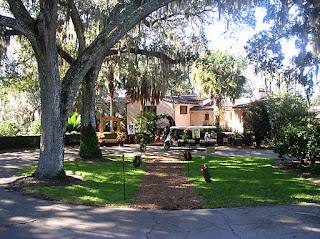Bok Tower as seen from the nature trail approaching the tower
The Peace Lantern
This Japanese stone lantern was a gift to the gardens as a tribute to Edward Bok to reflect his interest in world peace, symbolized by the dove carvings.
Becky and the Peace Lantern
Bok Tower is still obscured by trees.
A full view of Bok Tower
The Singing Tower is the centerpiece of the gardens. Its architect was Milton B. Medary, a prizewinning Philadelphia architect and President of the American Institute of Architects. The tower was built at the highest elevation of the site, south of a reflection pool that allows the water to reflect its full image. The tower is 51 feet (16 m) square at its base, changing form at 150 feet (46 m) high to an octagon with 37 feet (11 m) sides that include sculptures designed by Lee Lawrie. It is built of pink Etowah marble and grey creole marble, mined in Tate, Georgia, and Florida native coquina stone in a soft tan color, from Daytona Beach, Florida.
The small polychrome tile grille by artist J. H. Dulles-Allen shows lower orders of life found in the sea: seaweed, jellyfish, fish and seahorses. The grille above it represents Adam and Eve and the villainous serpent in the Garden of Eden.
The top of the tower features filigrees of ceramic tile by Dulles-Allen. These grilles present herons, smaller birds, baboons, in a brilliant blue color, and trees. The grilles, which are at bell-level, measure 10 feet wide and 35 feet high. The bells were made by the John Taylor & Co., Ltd. bell foundry of Loughborough, England. There are 60 bells in all, weighing from 16 pounds to almost 12 tons.
Inside the bell chamber is a playing room that houses a clavier, or keyboard, that is used for playing the carillon bells. Recitals are given daily from the 60-bell carillon set. The carillon bells ring on the half hour, and live performances can also be heard at scheduled times. One fun feature is an outdoor video that allows visitors to watch the carillonneur play in real time.
Wrought iron fences, gates and hardware were fashioned by America's premier metal worker,
Samuel Yellin.
An ironwork bridge across the moat
Detail of the ironwork on the bridge
Bird’s heads serve as finials atop the rods, and no two are exactly alike.
The bridge from the opposite angle
The tower is surrounded by a 15-foot (4.6 m) moat that serves as a koi pond.
Turning the corner of the moat
The sundial was designed by sculptor Lee Lawrie of New York.
Above the sundial is a band of sculpted marble figures which circles the tower. Lawrie’s sculptures typically portray tropical and subtropical plants and birds, such as pelicans, flamingos, herons, geese and swans. His flora and fauna are done in the Art Deco style.Continuation of the moat with a view of the sundial from the side
Koi in the moat
A wrought iron bridge over the moat on the opposite side of the tower
Edward Bok is buried at the base of the carillon,
close by a reflecting pool inhabited by two Mute Swans.
The ornate brass door leading into Bok Tower
It served as the entrance to Bok's own room, the Founder's Room.
The brass door and the burial place of Edward Bok
The brass door and the grave across a reflecting pool
A live oak tree looms over the reflecting pool in front of the tower.
Bok’s burial place is on the lower left hand side.
The reflecting pool in front of the tower
The tower and its reflection in the pool
This is the iconic view of Bok Tower, and I was happy to get a few of my own.
Maybe more than a few.
Bok Tower framed by a number of different varieties of trees
Another view of the tower
The tower with a closer view of the upper grille work
The purpose of the grilles by Dulles-Allen is to allow the sound of the bells to have enough open space to pass out freely.
The tower and its reflection
Becky with the tower in the background
Becky and Robert with the tower
This is without a doubt the most photographed vista in the Gardens.
Behind the tower is a beautiful and peaceful area of sweeping lawns and tall trees.
These trees are part of a live-oak grove that overlooks rolling hills of citrus trees.
Past the trees, the land drops precipitously.
The marble exedra, the semi-circular high-backed bench, was a gift to Edward Bok from friends.
The sunset view inspired Mr. Bok’s dream of the Gardens on his visits to Iron Mountain. At the elevation of 298 feet, this is one of the highest points in Florida.
The vista from the exedra
The view of the horizon seems to be far, far in the distance.
In Edward Bok's own words, he sums up the purpose of his Gardens:
The purpose of it all? Simply to preach the gospel and influence of beauty reaching out to visitors through trees, shrubs, flowers, birds, superb architecture, the music of bells, and the sylvan setting.And a restful, quiet, beautiful spot where visitors may feel, as the sign at the entrance declares by an extract from John Burroughs: "I come here to find myself. It is so easy to get lost in the world."
Edward William Bok, 1929























































































